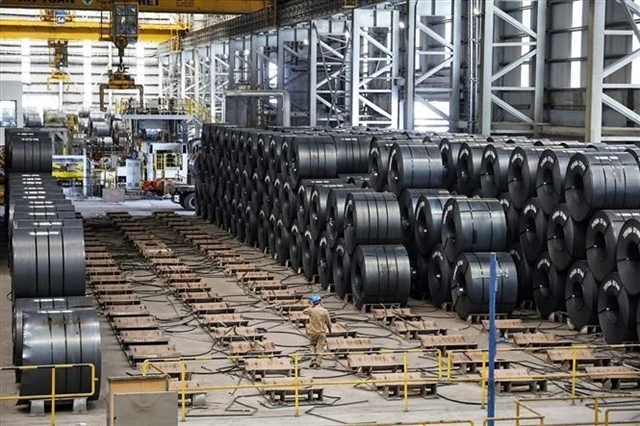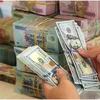
Hanoi (VNS/VNA) - Vietnam has navigated the first three quarters of the year through a complex and unpredictable global landscape, compounded by significant natural disasters at home.
Storms, floods, and prolonged heavy rains – particularly in the wake of Typhoon Yagi in early September – have disrupted economic and social activities, impacting both businesses and people's daily lives.
In response, following directives from the Politburo, the Government, and the Prime Minister, ministries, branches, and local authorities have implemented various solutions. These efforts aim to prevent further damage, respond effectively to ongoing challenges, and support the recovery of businesses and communities.
Despite these disruptions, Vietnam's economy has demonstrated resilience, as evidenced by strong third-quarter growth. International organisations and businesses have praised the country's swift recovery.
Fastest quarterly growth in two years
Last week, the General Statistics Office (GSO) held a press conference where GSO General Director Nguyen Thi Huong said that Vietnam's GDP grew by an estimated 7.4% in the third quarter of 2024.
This surpasses the 6.7% target set by the Government in early January, and marks the fastest quarterly growth since the third quarter of 2022.
Huong attributed this impressive economic performance to the rapid recovery in industrial production. The prompt resolution of power and telecommunications disruptions in storm- and flood-affected areas allowed businesses to resume operations quickly. The manufacturing and processing sectors, in particular, saw an 11.4% increase in added value - the highest rate recorded since 2019.
At a government meeting earlier this week, Minister of Planning and Investment Nguyen Chi Dung reported that Vietnam's economy had regained momentum, with strong recovery across all sectors in the first nine months of the year.
Key achievements included robust industrial production, export growth, and significant foreign direct investment (FDI) inflows. Macroeconomic stability had also been maintained, with inflation under control and key financial indicators - including the budget deficit, public debt, government debt, and foreign debt - remaining within acceptable limits.
Dung proposed a target of 7.6-8% growth for Q4, building on the positive results of the previous quarter. Achieving this target would help Vietnam meet or exceed its full-year growth target of 7%.
GSO General Director Nguyen Thi Huong added that achieving the 2024 GDP growth target of 6.8-7% would require significant effort. She calculated that growth in the fourth quarter would need to reach 5.7% to achieve 6.5% annual growth, 6.76% for 6.8% growth, and 7.5% for the upper target of 7%.
However, she expressed optimism, saying that the strong performance in the first nine months suggested the upper target is attainable.
While the Vietnamese government remains optimistic, international economic organisations have taken a more cautious view, particularly considering the lingering damage from Yagi and prevailing global economic headwinds.
The Asian Development Bank (ADB) projected a positive economic outlook for Vietnam, forecasting GDP growth of 6% in 2024 and 6.2% in 2025, according to its September Asian Development Outlook report.
Meanwhile, HSBC maintained its GDP growth forecast for Vietnam at 6.5% for both 2024 and 2025, noting that the country’s positive potential could offset the temporary economic losses caused by the typhoon.
The IMF has also forecast a recovery in economic growth, projecting 6.1% growth in 2024, supported by continued strong external demand, resilient FDI inflows, and accommodative policies.
Singapore-based United Overseas Bank has revised up its GDP growth forecast for Vietnam by 0.5 percentage points to 6.4% in 2024, from the previous projection of 5.9%.
Risks on the horizon
Despite the positive outlook, the ADO highlighted several downside risks that could slow Vietnam's growth momentum. Weak external demand in major economies will likely persist, and geopolitical tensions - particularly related to the US presidential election in November - could lead to trade fragmentation, which may negatively impact Vietnam's exports, manufacturing activity, and employment.
Other risks include weak domestic demand and gloomy global economic prospects. The US Federal Reserve’s rate cuts, along with similar moves from the European Central Bank, may also weaken Vietnam’s exports.
IMF experts warned that Vietnam's export growth could suffer if global growth falls short of expectations or if geopolitical tensions persist. If trade disputes intensify, exports - a key driver of Vietnam's economy - could weaken further.
Additionally, the IMF expressed concerns about the prolonged weakness in the real estate and corporate bond markets, which could weigh on banks' ability to expand credit, potentially slowing economic growth and undermining financial stability.
Economist Vo Tri Thanh, Director of the Institute for Brand and Competitiveness Strategy, highlighted the Vietnamese economy's vulnerability to external shocks, noting that growth remained heavily reliant on tourism, exports, and FDI.
He also expressed concern that the full impact of Yagi had yet to be fully assessed. The typhoon’s effects were expected to be felt more clearly in the northern region in late Q3 and early Q4, resulting in reduced output and damage to manufacturing, agriculture, and service facilities.
Another internal challenge to growth was the lag in public investment disbursement, which had fallen behind schedule. As of September 30, only 47.29% of the disbursement target had been met, compared to over 51% during the same period last year.
Minister Dung stressed that this shortfall was largely due to low disbursement rates in key localities despite large capital allocations.
For example, Ho Chi Minh City and Hanoi, which received significant allocations of over 79 trillion VND and 81 trillion VND, respectively, achieved disbursement rates of only 21.29% and 38.88%. These low rates significantly impacted the national average.
As a result, economist Thanh believed that achieving 7% growth for the entire year is optimistic given the current challenges.
Policy recommendations
To meet the growth target, Minister Dung emphasised the importance of a swift recovery from Typhoon Yagi to capitalise on year-end consumer spending, particularly during the Lunar New Year holiday.
He also stressed the need to prioritise resource allocation to finalise policies that will create an attractive environment for large-scale, high-tech investment. This includes revitalising traditional growth drivers - investment, consumption, and exports - while fostering new ones in areas like the digital economy and green transition.
Dũng also highlighted the importance of enhancing cooperation and economic dialogues with strategic partners to attract multinational corporations and strategic investors in key sectors like chips, semiconductors, and AI.
He recommended developing effective policy packages to support businesses and promote new growth drivers, particularly in semiconductor development, human resources for the tech sector, the international finance centre project, and carbon market development.
The minister also called on Hanoi and HCM City, as the country’s major economic hubs, to strive for higher-than-expected growth rates to help achieve the national target.
ADB experts recommended a coordinated policy approach focused on stronger fiscal stimulus, including accelerating public investment and maintaining low interest rates to stimulate demand. They suggested the central bank maintain a flexible monetary policy to support the country's economic recovery.
IMF experts proposed a multifaceted approach to medium-term economic growth, including safeguarding macro-financial stability, deepening reforms, and promoting green and inclusive growth.
They also recommended taking decisive action to address vulnerabilities in the real estate and corporate bond markets, including strengthening the insolvency framework and increasing transparency./.






















